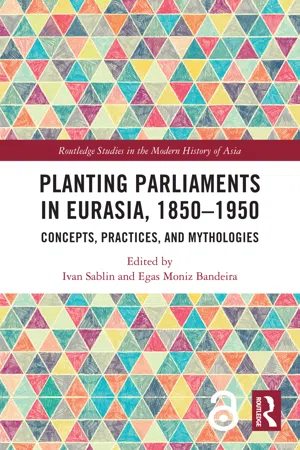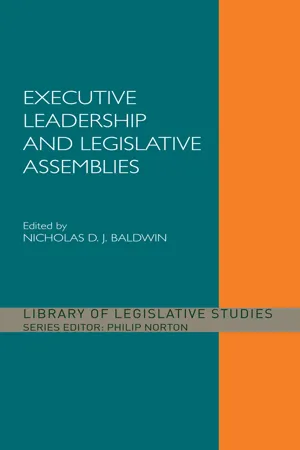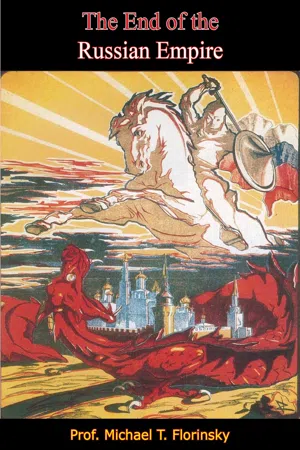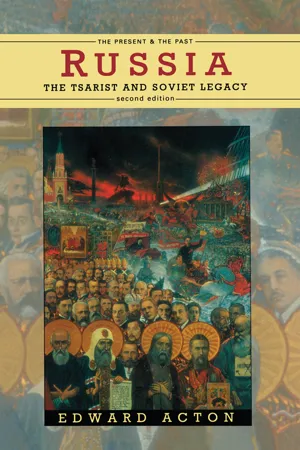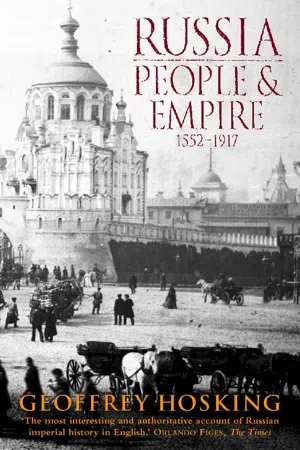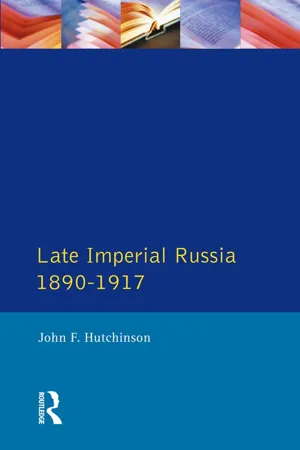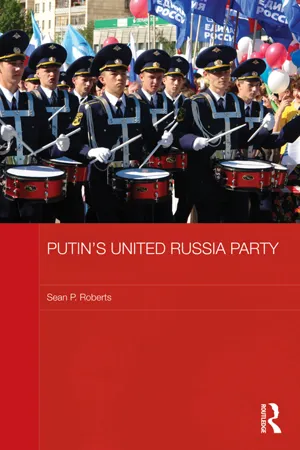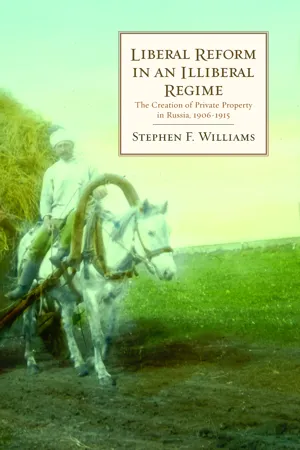History
Duma
The Duma was the Russian parliament established in 1905 as part of the country's move towards constitutional monarchy. It was initially intended to be a legislative body with limited powers, but it played a significant role in the political upheavals of the early 20th century, including the Russian Revolution. The Duma represented a key step in Russia's transition towards a more democratic political system.
Written by Perlego with AI-assistance
Related key terms
Related key terms
1 of 4
Related key terms
1 of 3
11 Key excerpts on "Duma"
- eBook - ePub
Planting Parliaments in Eurasia, 1850–1950
Concepts, Practices, and Mythologies
- Ivan Sablin, Egas Moniz Bandeira, Ivan Sablin, Egas Moniz Bandeira(Authors)
- 2021(Publication Date)
- Routledge(Publisher)
64Although initially it was designed as a consultative body, the establishment of the legislative State Duma (on October 17, 1905, in the so-called October Manifesto) and the adoption of the new Fundamental State Laws of the Russian Empire (on April 23, 1906) seemed to make Russia a constitutional state. In 1907, Vladimir Matveevich Gessen and Boris Emmanuilovich Nol’de, two prominent liberal legal scholars, listed Russia, together with Persia and Montenegro, as a new constitutional state in their comprehensive collection of contemporary constitutions. Articulating a popular progressive view, they claimed that the failures of the Russo–Japanese War unmasked the inefficiency of bureaucratic autocracy, spreading the critical attitudes to the ancien régime beyond intellectual circles and transforming them into a broad liberation movement across the whole country.65Indeed, before and especially during the Revolution of 1905–1907, the inefficiency of the Russian state played a key role in the broader debates on democracy, which contrasted the public and the bureaucracy. The liberal program included not only parliamentarization but also decentralization of the empire, with the introduction of zemstvo and municipal self-government on the basis of universal suffrage. As argued by Gessen, since bureaucracy lacked information on particular affairs, it could not govern them effectively and needed to be substituted by local and professional self-organization.66 The same logic applied to the parliament. Articulating a widespread opinion, the Tomsk liberal newspaper Sibirskaia zhizn’ celebrated the October Manifesto as the liberation of the people from “the tutelage of bureaucracy.” According to the newspaper, the Russian Empire had become a constitutional state and “joined the family of modern civilized states as an equal,” and in such a state the population had supreme authority. At the same time, Sibirskaia zhizn’ voiced a popular liberal argument in favor of gradual political change.67 - eBook - ePub
Historically Inevitable?
Turning Points of the Russian Revolution
- Tony Brenton(Author)
- 2016(Publication Date)
- Profile Books(Publisher)
5 Hundreds of thousands went on strike. The universities had to be closed down. There were uprisings in Poland, peasant violence in much of the countryside and, more ominously for the security of the regime, mutinies in the armed forces. Nicholas was forced into major concessions. The censorship was abolished. Personal and political rights were guaranteed. And, as a surrogate for the Constituent Assembly, Russia was given its first-ever national representative assembly, the State Duma.THE DumaRussia’s first experiment with giving the people a voice in government faced huge difficulties from the start. The gap between the reformers and the regime was almost impossibly wide. Nicholas was determined to concede none of his prerogatives. The ‘Fundamental Law’ establishing the Duma described him as ‘Supreme Autocrat’, and carefully avoided the explosive word ‘constitution’. In his view the very existence of the Duma depended on his autocratic whim. While the Duma did notionally have some serious powers, notably over government finance, the tsar retained control over the appointment of ministers, the power of veto, the power to dissolve the Duma, and the power to pass emergency laws while it was not sitting. Moreover, the electoral arrangements were rigged to produce a supportive assembly with one gentry vote worth that of forty-five workers or fifteen (supposedly more loyal) peasants. Nevertheless shrewd commentators attached real hopes to it. Sergei Witte, Nicholas’s most able minister (who indeed had pushed the tsar into agreeing to the Duma on the grounds that otherwise there would be revolution), confidently expected to see it evolve over time into a genuine Russian legislature.6The elections took place in April 1906. They were boycotted by the left-wing parties, which did much to encourage regime expectations of an acceptable result. The outcome was a huge shock. More than half the members of the new body were ‘semi-educated’ peasants, rough, rude and showing none of the class deference which the smooth Petersburg bureaucracy had confidently predicted. One horrified aristocratic observer described them as ‘A gathering of savages. It seemed as if the Russian land had sent to St Petersburg everything that was barbarian in it, everything filled with envy and malice.’7 - eBook - ePub
- Nicholas D. J. Baldwin(Author)
- 2014(Publication Date)
- Routledge(Publisher)
Bills are submitted to the State Duma and may be initiated by the president, the Federation Council or its members, deputies of the Duma, the government, or the representative bodies of the subjects of the federation. The various courts are also given constitutional authority to initiate legislation in the Duma on matters within their jurisdictions. However, bills relating to taxation, changes in the financial obligations of the state, or expenditures out of the federal budget may be submitted only with the consent of the government. In addition to its blocking powers mentioned above, relating to confirmation of the prime minister’s appointment, expressing lack of confidence in the government, overriding presidential vetoes, and superseding presidential decrees, the Duma can summon ministers to report on their work and answer questions, and it can conduct parliamentary inquiries and hearings relating to government activities.The State Duma also has the significant authority to initiate the impeachment of the Russian president. There are several steps in the process. The Duma, following upon an initiative of at least one-third of its deputies and the corresponding conclusion of a special commission, must bring charges, based on the grounds of high treason or another grave crime. If these findings are confirmed by a vote of at least two-thirds of Duma members, if the Supreme Court confirms that the presidential actions constitute a grave crime, and, further, if the Constitutional Court concludes that the established procedures have been observed, then the Federation Council must also vote, within three months, by a two-thirds majority to remove the president from office.The Russian Parliament: A Ten-Year AssessmentThe 1993 elections to the State Duma produced a parliament divided into three camps: three parties that could be labelled ‘democrats’, three that were centrist, and three that were in the left-wing opposition. The party that received the most publicity, by virtue of coming in first in the party-list vote, with about 23 per cent, was the ill-named Liberal Democratic Party of Russia (LDPR), an ultra-nationalist party led by the demagogic Vladimir Zhirinovskii. Although the democratic parties captured more than a third of the Duma’s seats, these were evenly split between party-list seats and single-member districts. Subsequent analysis showed that left-wing opposition parties benefited from the proportional representation system, while democratic parties would probably have fared better had all the seats been allocated in single-member districts. Moreover, the democratic parties undercut their opportunities for more district seats by competing against each other. As one study concluded, ‘democratic parties exhibited a higher frequency of internecine competition with detrimental consequences than did opposition parties’.12 - eBook - ePub
- Prof. Michael T. Florinsky(Author)
- 2017(Publication Date)
- Borodino Books(Publisher)
CHAPTER 5—THE RISE AND FALL OF THE Duma
The Weakness of the Duma
THE HISTORY of the vicissitudes of the Duma during the War presents a subject of unusual interest. From the subordinate position of a quasi-parliament in a State that in its legal structure was not too remote from an absolute monarchy, the Duma rose in the course of the War to a height of national leadership and prestige which would have appeared unthinkable a few months before. It will be no exaggeration to say that throughout the years 1915 and 1916 and the first two months of 1917 the Duma was regarded by that relatively small group—but the only articulate group—of men and women who constituted public opinion, as the standard bearer of the ideas of statesmanship and the champion of the national cause against the forces of reaction. Nevertheless at the very moment when these forces were defeated and disappeared from the stage the Duma lost ground almost at once. In the great upheaval that followed the downfall of the monarchy new social forces, new ideas were flung to the surface by the mighty waves of the revolutionary storm, and they made a clear sweep of the institution which for a few months was undoubtedly the moral leader of the nation. An illegitimate child of western democratic ideas and of the Russian autocracy, the Duma suffered from that debility which was a natural consequence of the half-hearted legislation which brought it into being. Like the rest of the constitutional and social structure of the State it bore in itself the germs of its own destruction. The most important of them was the Election Act of June 3, 1907. - eBook - ePub
- Richard Sakwa(Author)
- 2020(Publication Date)
- Routledge(Publisher)
The 1993 constitution abolished the two-tier system of Congress and Supreme Soviet and created a bicameral Federal Assembly: the upper house, the FC, made up (at the time) of 178 representatives, two each from Russia’s 89 federal components; and the lower house, the State Duma, with 450 deputies elected for a four-year term (apart from the first two-year convocation). The establishment of the Federal Assembly marked a decisive break with Soviet traditions. The constitution outlined the functions of the two chambers of parliament, with the powers granted to the Assembly balanced by countervailing powers of the executive. Although the powers granted the Federal Assembly are relatively weak, they are far from negligible. The First State Duma elected in December 1993 was an interim one and lasted only two years. A mixed electoral system was adopted for the first four Dumas, with half the deputies elected by a proportional PL system and half from single-member constituencies; whereas the elections to the Fifth in 2007 and the Sixth in 2011 were entirely proportional, before returning to the mixed system to elect the Seventh in 2016. The composition of the Duma reflects a combination of a stable core membership and a fluid periphery.The First Duma (1994–95)
Elected for a two-year transitional period, this convocation was fragmented and torn between a large nationalist bloc in the form of Zhirinovsky’s LDPR, a liberal group focused in Gaidar’s Russia’s Choice and a Communist bloc (Table 10.1 ).The Second Duma (1996–99)
The Second Duma was less fragmented than its predecessor, and the presence of only four factions dramatically altered its voting dynamics, with fewer smaller factions to mediate and moderate policy-making (Table 10.2 ). The more radical deputies elected from the party lists were diluted by members elected from the constituencies, often without any clear political affiliation, but the cost was a lack of clear political orientation in the Duma itself.2 The Duma contained 157 members of the old Duma (35 per cent), 49 per cent of the new convocation had been legislators at various levels before, 52 had worked in various executive branches, 15 had previously been members of the FC and 29 per cent came from Moscow.3 Although the CPRF did remarkably well, winning 149 seats, the pro-Communist bloc with 45 per cent of the seats failed to obtain the two-thirds required to overturn a presidential veto. The CPRF faction reflected the age profile of the party as a whole, with over one-third over 50, and another 6.5 per cent over 60; workers accounted for no more than 7 per cent.4 - eBook - ePub
Russia
The Tsarist and Soviet Legacy
- Edward Acton(Author)
- 2014(Publication Date)
- Routledge(Publisher)
During the months which followed the Moscow uprising strength was gradually restored to the Tsarist regime. The Far Eastern Army was brought home and a massive French loan floated by Witte helped cover the huge costs of the war and the drop in direct tax receipts from the peasantry. Yet disturbances continued. During 1906 there were frequent strikes and workers energetically set about testing the authorities’ ability to uphold the restrictions on trade-union organization. The illegal socialist parties enrolled tens of thousands of new working-class and peasant members, there were repeated student demonstrations, and the number of terrorist attacks on government officials rose. Serious peasant disorders were reported throughout the year, and there were further significant mutinies within the armed forces. These conditions ruled out an abrupt disavowal of the October Manifesto. Repressive measures, it is true, were gradually intensified. Between October 1905 and April 1906, some 34,000 rioters were shot, of whom an estimated 14,000 died. And from summer 1906 the trade unions came under sustained attack as the police moved in to arrest leaders, forbid meetings and close down a growing number outright. But the regime’s authority was fragile. Even reactionary ministers were acutely anxious not to risk a repetition of the extreme isolation of 1905. Thus initially the government moved with caution.An uneasy balance between reform and reaction was reflected in the Duma Statute and the Fundamental Laws issued in February and April 1906. As promised, a Legislative Assembly, the State Duma, was to be established, elected on the broad franchise conceded during December. The Duma’s consent was required before any change could be made to the Fundamental Laws; it was to control a portion of the budget; and its members were given immunity against prosecution. On the other hand, the State Council was to be preserved, and was to form an upper chamber designed to counterbalance any radical tendencies in the Duma. Half the councillors were to be appointed by the Tsar, and the other half were to be elected from such reliable institutions as the Holy Synod, the provincial assemblies of the nobility, the zemstvos, and the city Dumas, as well as the academic and business communities. This guaranteed an overwhelmingly conservative body: even among elected members, three-quarters were certain to be noblemen. Moreover, even when both houses approved a piece of legislation, the Tsar retained an absolute right of veto, and should an emergency arise while the Duma was not in session, Article 87 enabled him to legislate by decree. The Tsar’s control over foreign and military affairs was unqualified. Above all, the government was responsible to him alone: no amount of criticism from the Duma could dislodge his chosen ministers. These arrangements reflected anxiety to conciliate public opinion without losing control of the executive. The same anxiety led to several unsuccessful attempts by Witte and, later in 1906, by one of his successors, P. A. Stolypin, to persuade prominent Kadets and Octobrists to join the Cabinet. On the one hand, leading ministers genuinely wanted to broaden the government’s base, but on the other, the Tsar himself was decidedly unenthusiastic and the Kadet leader, P. N. Miliukov, and the other public figures approached gained the clear impression that they would be mere hostages in an administration run in the old spirit. - eBook - ePub
Russia: People and Empire
1552–1917
- Geoffrey Hosking(Author)
- 2010(Publication Date)
- Fontana Press(Publisher)
At the beginning of the twentieth century, Russia had abruptly embarked on a remarkable experiment. Its rulers were trying, half-accidentally, half-deliberately, to transform a multi-national empire into a nation-state, and an autocracy into a constitutional monarchy. Russia was taking the first steps towards creating both an ethnic and a civic nation out of the diverse and scattered materials of the old empire. The attempt was unsuccessful: that was scarcely surprising. What is remarkable is that it was made at all. And, having been started, it plunged Russia into a political turmoil from which it has not re-emerged even today.This attempt to redefine Russia’s political identity was not undertaken willingly, but was precipitated by the revolution of 1905, at the height of which the regime was in such straits and the danger of disintegration so great that it conceded to the population, in the October Manifesto, a guarantee of civil rights and a broadly elected legislative assembly. Both innovations went entirely contrary to Russia’s previous political traditions; both attempted to create in a few months what in most European nations had taken centuries to evolve.The powers accorded to the Duma, the new legislative assembly, were roughly equivalent to those held by the Reichstag in Germany, or the legislatures of Austria and Japan. It was part of a bicameral system, the upper house being a reformed State Council. Both chambers had the right to initiate bills, to amend them and to veto bills of which they disapproved. The government, for its part, had the right to issue emergency provisions, under article 87 of the Fundamental Laws, but they had to be approved subsequently by both houses.The government continued to be appointed by the Emperor, and he normally chose senior civil servants, so that neither house had direct influence on the selection of a ministerial team. One major change had, however, taken place. In 1905, Witte had been appointed Chairman of the Council of Ministers, in effect prime minister, with responsibility for coordinating government policy. Therewith the Emperor’s own haphazard regulation of his ministers’ disparate fiefs came to an end – a gain for the consistency of government policy, but a palpable curtailment of his own prerogatives. Witte tried to strengthen his own independence of the court by inviting representatives from the zemstvo congresses to join his government, but found them reluctant to diminish their own moral authority by making common cause with the ‘oppressors’ unless they had cast-iron guarantees of reform. Some of them demanded a Constituent Assembly and the four-tail formula.2 - eBook - ePub
Lenin's Electoral Strategy from 1907 to the October Revolution of 1917
The Ballot, the Streets—or Both
- August H. Nimtz(Author)
- 2014(Publication Date)
- Palgrave Macmillan(Publisher)
While the Marxist summer school Lenin envisioned couldn’t convene, a delegated Bolshevik meeting did take place in the same location not far from Cracow at the end of September 1913 during the summer recess of the Duma. All the Bolshevik deputies, except for one who was sick, participated in the second or Cracow II meeting. Duma strategy and tactics, as always, depended on the larger political context. The resolution on “The Present Situation,” the first of nine, affirmed that the “situation in the country is becoming increasingly acute” and reaffirmed the currency of the “revolutionary slogans”: the democratic republic, the confiscation of landed estates, and the eight-hour day. In the discussion and resolution on “Activities in the Duma,” refinements were made on the tactics of bill writing and voting:If bills, motions, etc., concern immediate and direct improvements in conditions for workers, minor salaried employees and working people generally (for example, reduction of hours, increase of wages, the removal of even minor evils in the lives of the workers and of broad sections of the population in general, etc.), the clauses that provide for such improvements should be voted for.In cases when the conditions the Fourth Duma attaches to these improvements make them dubious, the group should abstain from voting, but must unfailingly formulate its motives for so doing, after having first discussed the question with representatives of workers’ organizations.This Conference affirms that: on all questions, important bills, etc., the Socialist-Democratic group in the Duma must independently formulate its own motion to pass on to next business.In cases of the group’s vote against the government, after the Social-Democratic motion has been rejected, coinciding with the vote of other parties, the group must endeavor to formulate its own motives for voting for another party’s motion, or part of a motion.90On what was clearly the most pressing agenda item—the situation in the Duma group—the meeting, after describing how “the seven deputies encroach on the elementary rights of the six workers’ deputies who represent the overwhelming majority of the workers of Russia,” proposed a solution:This Conference is therefore of the opinion that united action on the part of the Social-Democratic group in the Duma is possible only if the two sections of the group enjoy equal rights, and if the seven deputies abandon their steam roller tactics. - eBook - ePub
- John F. Hutchinson(Author)
- 2014(Publication Date)
- Routledge(Publisher)
On the eve of the Duma's convocation – set for 27 April 1906 – the tsar, faced with the prospect of more political turbulence, suddenly dismissed the energetic but unruly Witte from the Chairmanship of the Council of Ministers, replacing him with Ivan Goremykin, an aging and obedient bureaucrat who was unlikely to work towards any sort of accommodation with the Duma. His appointment was regarded as a deliberate provocation by most deputies, especially the Kadets, who used the rostrum of the Duma to condemn the government, lecture the ministers, and (as they thought) rally support for their party by calling for land expropriation, a political amnesty, ministerial responsibility, and an end to arbitrary and bureaucratic government. When Goremykin made no positive response on any of these issues and explicitly ruled out the expropriation of private land, many deputies boldly decided to communicate directly with the people; from the relative safety of Vyborg, just across the Finnish border, they composed an address to the population. The government quickly condemned this ‘clearly illegal’ act and, in order to teach the upstart deputies a lesson, it dissolved the Duma (8 July 1906) and called for new elections. Although elected for a five-year term, the First Duma had lasted scarcely more than two months. Only convinced reactionaries thought this was the moment to abolish the Duma completely, but there was a notable absence of public protest over the dissolution itself [ Doc. 13 ], In the countryside, however, peasants who had expected the Duma to present them with the nobles’ land vented their frustration in a fresh wave of arson and disorder. The election results dispelled any hope that the Second Duma would prove more tractable than its predecessor - eBook - ePub
- S. P. Roberts(Author)
- 2012(Publication Date)
- Routledge(Publisher)
Figure 4.2 State Duma Law-Making (1996–2007). Source: Duma (2011).As shown in Figure 4.2, the emergence of United Russia as a dominant force in the national legislature coincided with increased productivity, evident in the number of laws passed and, subsequently, rejected by the president and Federation Council. The fact that the number of laws signed by the president in this period also increased further testifies to the rationalisation occurring between executive and legislative branches as well as the personal interest shown by Putin in the legislative process. It is worth noting that, by the end of 2010, the Fifth Duma Convocation has already passed more items of legislation (1,176) that any of the four previous convocations, even though there are two more sessions left before the December 2011 State Duma election (Duma 2011).Despite the fact that executive–legislative relations have been more productive in the post-Yeltsin period, records of the legislative activity in the Third and Fourth Duma Convocations show that the majority of laws passed had only an indirect relationship with dominant-power politics. Many of the laws passed in the period 2000–10 were designed to strengthen the effectiveness of the state and to continue Russia’s consolidation of a market-based economy. These laws are too numerous to list, but in the first two years of Putin’s presidency included laws aimed at the de-bureaucratisation of the economy and the reduction of administrative barriers, as well as tax, pension, banking and land reform among others (see Remington 2005: 34). For the most part, economic reforms conducted in Putin’s first term of office were largely well received by international observers and liberal opposition alike.For example, a US Congress report from 2002 noted the positive administrative and legislative changes made shortly after Putin’s arrival as president, which gave Russia a more ‘market friendly climate’ (Goldman 2002: 21). Boris Nemtsov, a prominent opposition politician in the post-Yeltsin period, also gave a positive estimation of Putin’s reforms in his first term of office noting that ‘I supported Putin when he liberalised the tax-system and when he tried to protect small business from bureaucracy, when he tried to make the legal system transparent’ (Nemtsov 2007). However, these positive estimations began to change during Putin’s second term of office, 2004–8, as the pace of economic reform began to slow and as the political system became increasingly authoritarian. - eBook - ePub
Liberal Reform in an Illiberal Regime
The Creation of Private Property in Russia, 1906-1915
- Stephen F. Williams(Author)
- 2013(Publication Date)
- Hoover Institution Press(Publisher)
The agrarian reforms are linked not only to the government’s use of Article 87 in November 1906, but also to two other key moments in Russia’s abortive constitutional experiment. First, as a focal point of conflict between the tsar and the First Duma, agrarian issues helped bring on the tsar’s proroguing of the First Duma in July 1906, at the moment of Stolypin’s accession to the prime ministership. The proroguing was a perfectly lawful act, but it reflected Russia’s apparent inability to muster the rudimentary cooperation needed for a state to function with separate executive and legislative authorities—at least as then constituted. The Second Duma, elected in early 1907, was much farther to the left than the First and thus held out even fewer prospects for joint action on agrarian issues. There followed the tsar’s June 3, 1907, dismissal of the Second Duma—a more fateful event, as the tsar simultaneously replaced the existing election rules with ones more favorable to non-peasant landowners. Only after this move, often characterized as a coup d’état, could Stolypin secure legislative approval of his property rights reform.Yet Stolypin saw his agrarian reforms as part of an effort to build a rule-of-law state, with peasants acquiring the legal rights of full citizens and thus—he hoped—the attitudes of full citizens. Indeed, he accompanied his agrarian provisions with others reducing the legal boundaries between peasants and the rest of society. But means and ends did not jibe well. Reliance on Article 87, even if strictly legal, plainly did not advance the cause of constitutional government, conceived as a system where authorities are balanced and government action depends on the consent of the governed. So we must look at the alternative policies not simply as possible answers to the “agrarian question,” but also as possible strands in a scenario that might have enhanced constitutionalism—and thus moved Russia both politically and economically toward liberal democracy.Composition of the First Duma
Elections over the late winter and spring of 1906 yielded a Duma leaning toward complete or partial expropriation of the pomeshchiki. And this left-wing composition emerged despite two obstacles. First, the electoral system was weighted in favor of landowners and against peasants (and workers), with a ratio of one representative for every 2,000 landowners, one for every 30,000 peasants, and one for every 90,000 workers.2 Second, two major left-wing parties, the Social Democrats (later to split formally into Bolsheviks and Mensheviks) and the Social Revolutionaries (the party explicitly claiming to represent the peasants), boycotted the elections.3 An exact count of deputies’ party affiliations is impossible because the Duma was dissolved before the elections were complete throughout the country; the most reliable breakdown of deputies relates to a point where 478 (out of a theoretical 524) had been elected.4 In the (relative) center were 185 Kadets, including about forty leaning toward socialism. To their right were seventy deputies: Progressives (including the Group for Peaceful Renewal), Polish National Democrats, Octobrists, and other moderates. And to their left were another 111, including the Trudoviki, Social Revolutionaries, and Social Democrats, all obviously most unpromising as potential allies of the government. Finally, there were “nonpartisans,” some of whom were possible allies for a reform of allotment property.5
Index pages curate the most relevant extracts from our library of academic textbooks. They’ve been created using an in-house natural language model (NLM), each adding context and meaning to key research topics.
Explore more topic indexes
Explore more topic indexes
1 of 6
Explore more topic indexes
1 of 4
